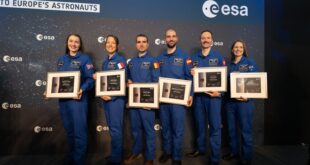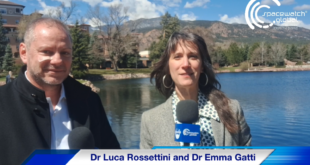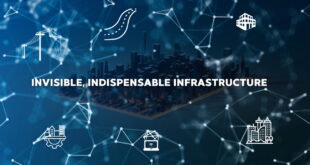As space technology continues to develop at pace, we are seeing larger numbers of satellites being launched than ever before. Used for communication, navigation, earth observation and scientific development (to name but a few), these satellites provide some incredible services and insights required for the everyday functioning of our society.
 According to ESA data, at the beginning of July 2021, there were 7,510 satellites currently in Earth’s orbit. However, approximately 4,500 are in fact functioning, meaning that around 40% of these satellites are redundant. That is a striking proportion of satellites which are no longer serving a purpose, creating ‘space junk’.
According to ESA data, at the beginning of July 2021, there were 7,510 satellites currently in Earth’s orbit. However, approximately 4,500 are in fact functioning, meaning that around 40% of these satellites are redundant. That is a striking proportion of satellites which are no longer serving a purpose, creating ‘space junk’.
Catastrophic consequences
The ramifications of collisions in space can be extremely dangerous. In 2009, a Russian military satellite and a privately owned American satellite collided, which resulted in not only the destruction of both objects, but also created 2,300 fragments of space debris.
Space debris in itself is one of the most pressing issues in space activities today, and there is a growing amount being added to the already large numbers. Data suggests that the number of debris in orbit is around:
- 34,000 objects greater than 10 cm
- 900,000 objects from greater than 1 cm to 10 cm
- 128 million objects from greater than 1 mm to 1 cm
Although the size of these objects may not seem significant, in the context of a collision with a spacecraft, a 1mm object has the potential to destroy a subsystem it comes into contact with, whilst a 10cm object could completely fragment a standard satellite.
Clearly, the risk posed by space debris can be catastrophic, a risk which only going to increase alongside the increased number of satellites being launched in to orbit.
Not just in space
The dangers of increased spacecraft activity do not just remain in space. In May 2021, we were reminded of the dangers on Earth, when debris from the Chinese Long March-5b rocket crashed into the Indian Ocean. Had this been directed in a populated area, the consequences would no doubt have been far more severe.
Action needs to be taken
This is not an issue which can wait any longer, and governments and industry are starting to take serious action in order to control this problem. Companies such as Astroscale and D-orbit are creating innovative solutions for the safe removal of space debris.
Alongside the ramping up of commercial activities, authorities are starting to implement procedures to ensure the sustainable use of Earth’s orbit. The World Economic Forum (WEF) has recently announced the implementation of a Space Sustainability Rating (SSR).
The SSR, which will come into action in early 2022, has been developed in order to reduce the volume of space debris and encourage space organizations to implement safer and more sustainable management of their missions. This will be done by providing their operations and activities (including satellite launches and crewed missions) to attain certifications for sustainability scored on considerations including “data sharing, choice of orbit, measures taken to avoid collisions, plans to de-orbit satellites on completion of missions, and even how well they can be detected and identified from Earth.”
This is just one approach which promises to provide further guidance and encouragement for sustainable practices in the industry. Other activities, such as those carried out by ESA’s Clear Space Office as well as calls to action from the United Nations Office for Outer Space Activities, show additional progress being made in all levels of industry.
Towards a safer future
The use of space will continue to grow, and that is something which is inevitable due to the advantages it creates. It will improve the way we can communicate, the way we can protect our environment, even the way that we strengthen our economies.
However, in order to continue providing these benefits it is important that space organisations and governments alike begin to enforce more stringent approaches to how they act. Given the increased focus by all industry stakeholders in creating more sustainable practices, the outlook is certainly looking very positive for the future of space.
Keen to learn more on these subjects? Come and join us at the Space Tech Expo Europe 2021 Conference– register for your free pass here.
As part of the partnership between SpaceWatch.Global and Space Tech Expo Europe, we have been granted permission to publish selected articles and materials. This post is originally published at: https://www.spacetechexpo.eu/keeping-space-sustainable/

Event Fact Sheet:
Key Exhibitors:
Skyrora, DLR, OHB, Tyvak, ArianeGroup, AIRBUS, KSAT, ESA, Satlantis, Valispace, AAC CLYDE SPACE, Space Structures, exotrail, Morpheus Space, NewSpace Cube, D-Orbit
Link to Exhibitor list: https://www.spacetechexpo.eu/exhibitor-list/
Number of Speakers: 75+
Key Speakers:
Pascale Ehrenfreund, President, International Astronautical Federation
John Auburn, Managing Director, Astroscale Ltd.
Prof. Dr.-Ing. Anke Kaysser-Pyzalla, Chair of the Executive Board, DLR
Andreas Lindenthal, Head of Space Systems Business Operations and Products – Head of Space Systems Germany, Airbus Defence and Space
Jeanne Medvedeva, VP of Launch Services, Exolaunch
Ian Annett, Deputy CEO for Programme Delivery, UKSA
Stefan Brieschenk, Chief Operating Officer, Rocket Factory Augsburg AG
Link to full conference agenda: https://www.spacetechexpo.eu/conference/conference-agenda
Useful pages:
– Why attend: https://www.spacetechexpo.eu/visit/
– Covid Safety: https://www.spacetechexpo.eu/information/covid-safety






